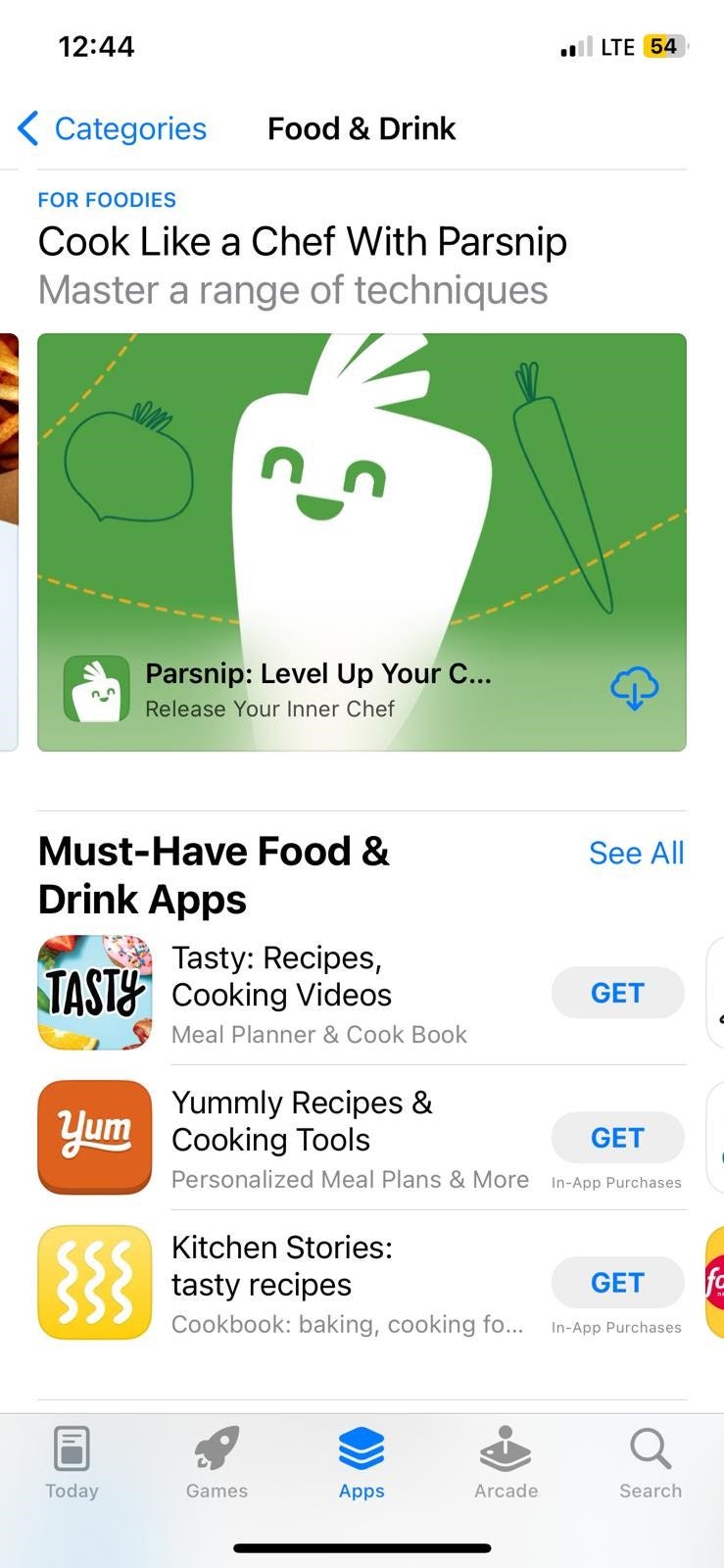How to personalize learning with AI 👩🎓
Solving Bloom's "2 sigma" problem by using skill trees to learn anything
“Education is not preparation for life; education is life itself.”
— John Dewey
Friends, it’s been a while.1 But I’m excited to share a renewed vision for Parsnip.
We started Parsnip to solve the cooking problem. But as we dug in, we realized that the biggest part of being able to cook is learning how to cook. And the more we worked on making that learning as easy as possible, the more we realized that the process of how we learn in general is broken.
Mass education is a one-size-fits-all solution that is expensive, scales poorly, and frustrating for both teachers and learners—and the learning paradigm we developed for Parsnip has implications far beyond just cooking.
Benjamin Bloom’s legacy
To explain our thesis about learning, we need to first rewind a few decades. If you haven’t heard of Bloom’s 2-sigma problem, here’s a quick review.
In 1984, Benjamin Bloom wrote a seminal paper2 in which he studied over 12 different ways to improve educational efficacy. One particular paradigm stood head and shoulders above the others—it was so good that it took the median student to the 98th percentile: that’s an astounding 2 standard deviations (σ, or sigma) better.
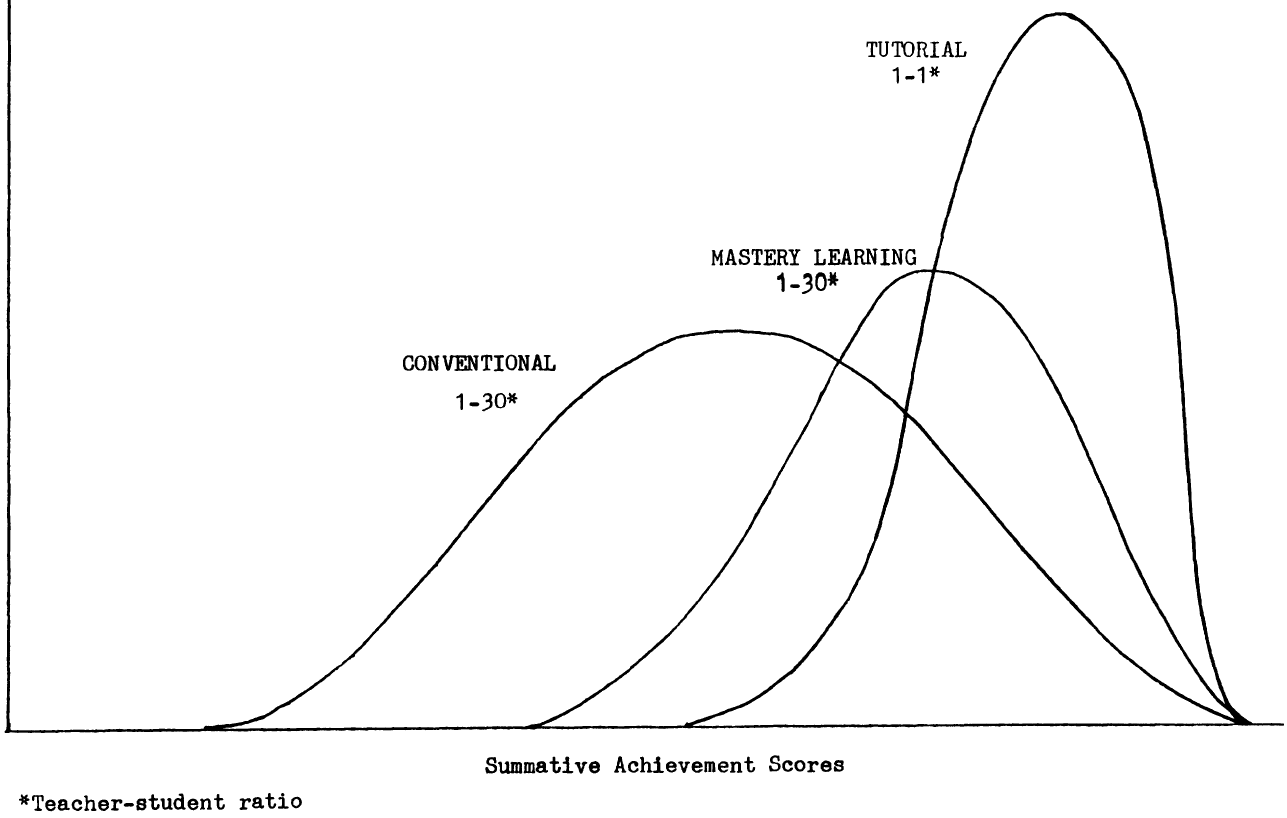
This “2-sigma” effect resulted from two parts:
Mastery learning, where a student must demonstrate proficiency in one topic before moving on to a subsequent one.
1-to-1 tutoring, where teachers provide individual attention to students.
You might immediately see that this isn’t how most education in schools currently works—instead, it’s a one-size-fits-all approach with 1-to-many instruction and all students forced to learn at the same rate. Bloom’s observation suggests we should instead “personalize” education in some way.
His result also corroborates how effective learning was delivered for centuries in a personalized, modular, interactive way with constant feedback, in the form of apprenticeships and private tutoring. Yet, this highly effective way to learn is costly and doesn’t scale, as it’s limited by the number of available teachers.
Bloom goes even further to note that almost anyone can learn this effectively, but that 1:1 tutoring would be too costly to implement at large scale. He concluded that instead, educators needed to design methods of group instruction that would be equally as effective. This is Bloom’s 2-sigma problem3.
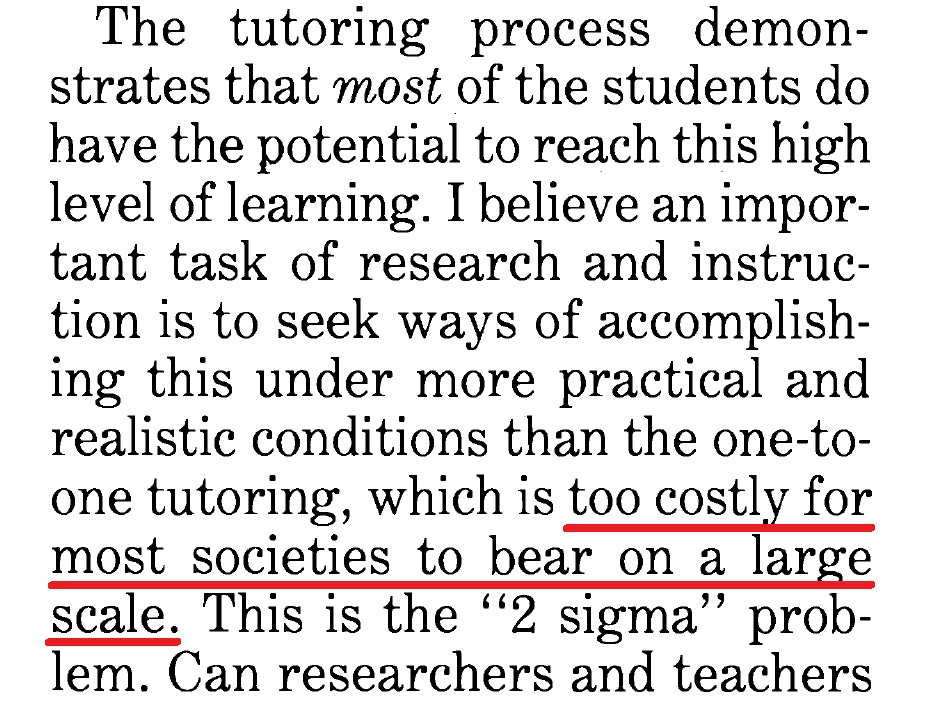
Can technology solve the 2-sigma problem?
Bloom posited that the solution to the 2-sigma problem would need to be better methods of group instruction. But maybe he was wrong to assume that 1:1 tutoring wasn’t scalable.
Decades later, an obvious approach to deliver personal tutoring at scale is through technology. As a result, mounds of capital have been thrown at edtech, but to no avail4. The most recent wave of this unfulfilled promise was a tsunami of MOOCs that resulted in little change.
What are we getting wrong? If we look at the 2-sigma effect from first principles, we know that the combination of mastery learning and 1:1 tutoring is the best hypothesis we have for the key ingredients to effective personalization.
The problem is that there are many ways to interpret these two ideas. But after working on this for a while, we are convinced that at the core of each is the following:
Mastery learning: knowledge is broken up into chunks, and learning means understanding one chunk before going the next one.
1:1 tutoring: the teacher has a theory of mind5, a mental model about what the student knows and doesn’t know, and can proceed at the pace of the student
To summarize, one way to personalize is to create a learning system that has a theory of mind about what the student knows and doesn’t know, then allows the student to “choose their own adventure” and master each topic at their own pace.
If you were to build such a system, how would you implement these ideas?
Parsnip’s core thesis
This brings us to the core insight for Parsnip. Why not steal an idea from video games—the skill tree? Here’s an example from Star Wars Jedi: Fallen Order.
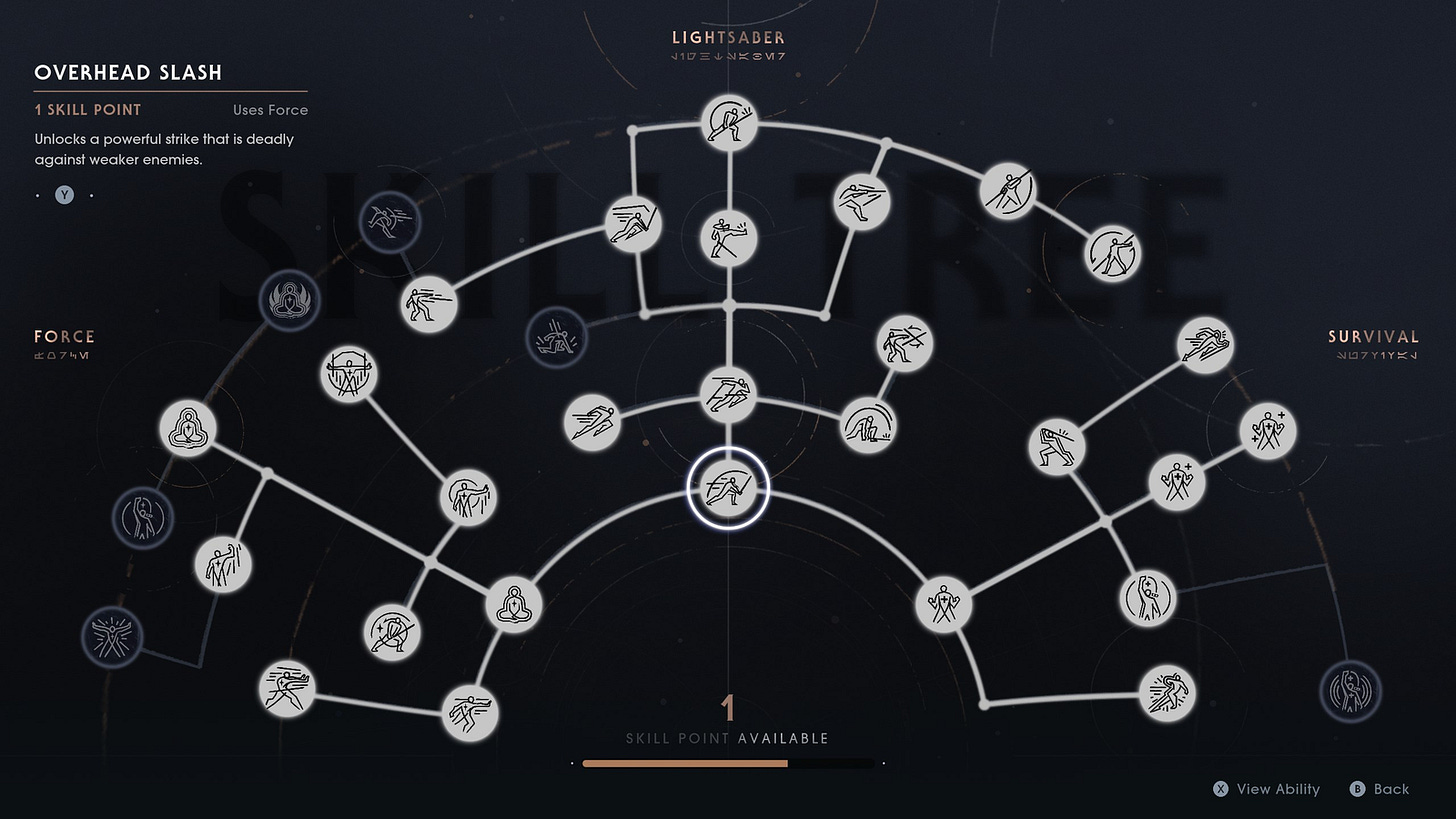
When you play a character in a video game, skill trees are an effective, engaging way to see your character progression. You can see the abilities you’ve gained and what you can unlock next. And crucially, skill trees are a tried-and-true mechanic of many fun and highly engaging games6.
Why can’t we do this for real life skills? A skill tree would provide a scaffold of knowledge, like an interactive syllabus, that shows you what you’ve learned and what you can learn next. It can also track what skills you haven’t used in a while and might want to practice again.
Until now, we haven’t quite had the tech to do this. It’s been difficult and costly to map out the knowledge of an entire domain as a skill tree. Creating content that helps you “learn” each skill is expensive. And most importantly, it’s hard to concretely connect abstract skills you’ve learned to tasks you’re doing in the real world.
All of this is no longer true with the advent of AI, LLMs, and the widespread availability of both cloud and mobile machine learning. Skill trees also mitigate two weaknesses of GenAI / LLMs used alone: (1) the scaffolding creates “physics” or guardrails around unstructured output, and (2) the knowledge map provides context about you for LLMs to be personalized.
Both the structure of the skill tree and content for each skill can be generated dynamically and even on-the-fly, like a real tutor with a theory of mind about the student’s understanding. Machine learning models can connect real-world tasks to their related skills in an automated fashion, cheaply and at large scale. In other words, it’s now possible to generate an “AI-powered Duolingo” for anything you’d like to learn.
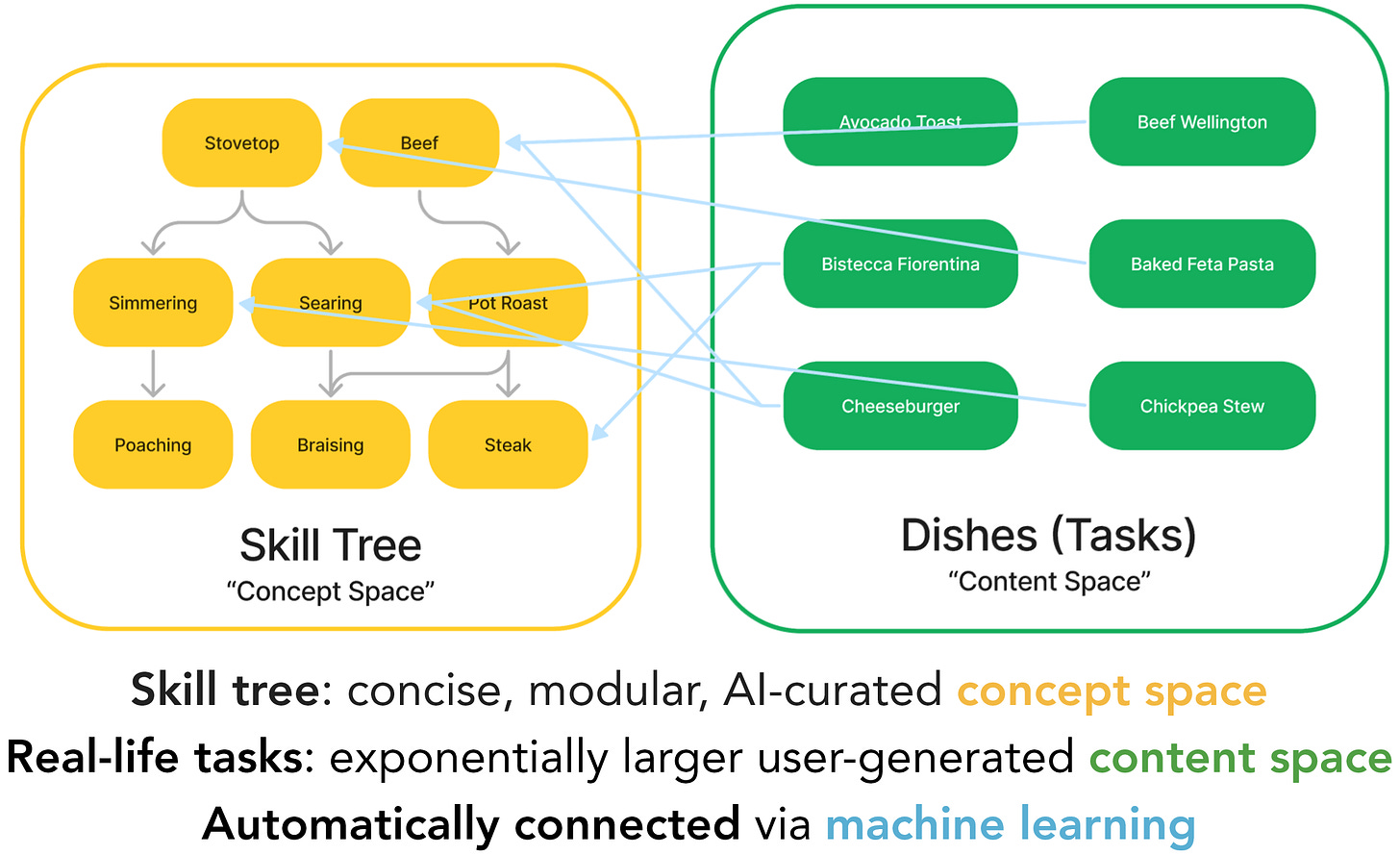
Skill trees operationalize the theory of mind in 1:1 tutoring, providing a map of what you’ve explored and what you haven’t. They also naturally allow for progression across discrete chunks of knowledge—the core of mastery learning. But there’s an important difference from private tutoring: just like with MMORPG video games, they scale at almost zero marginal cost.
Parsnip’s thesis: AI-powered real-life skill trees can “Duolingo-ize” anything,
are a scalable solution to Bloom’s 2-sigma problem,
and the key to personalized education.
Maybe this sounds crazy to you. But how would the world look if it worked? Skill tree-based learning would transform “education”, turning it from an oft-dreaded environment to a real-life game. Instead of one-size-fits-all lectures or pre-recorded content, we’d have a new learning paradigm: personalized, on-demand, interactive, engaging consumer products that are integrated into your life. Instead of being relegated to a small part of your life, learning becomes far more effective as a constant part of it. Powered by software, this model can reach anyone on the planet, supercharging how quickly we can absorb knowledge into our brains.
The future of education won’t look like a classroom or even a MOOC, but continual learning that’s part of doing in everyday life. And that’s why skill trees are promising—they can teach you anything, not just what’s in school.
In fact, if one were trying to launch a new product with this idea, it would probably be easier to get to market by teaching something that isn’t widely available in school, but is still in high demand for real life. And to really prove out its potential, we apply it to an everyday skill that anyone can benefit from leveling up on constantly. What skill comes to mind for you?
An unconventional application of skill trees
If you’ve been following Parsnip, you’re probably not surprised that we’re applying skill trees to cooking. But it’s particularly favorable initial vertical for this technology, as well as a compelling business, for several reasons:
In demand: cooking is hard to learn on your own, and prevailing conditions have created strong market tailwinds with many people looking for a solution.
Underserved: we used to learn to cook from our parents and our schools, but not anymore. Few products exist to address this problem. The main competitors are cooking schools (expensive and inaccessible), or YouTube & TikTok (unspecialized, horizontal platforms that are often ineffective7).
A painkiller, not a vitamin for the ICP—beginner cooks who don’t know where to start. They’re everywhere: we spent a couple hours combing Reddit and easily found over a hundred relevant posts.
Large eventual market (TAM) with fertile ground to create a platform business that doesn’t yet exist.
A sticky, high-retention product is likely attainable because cooking is a skill that’s used every day.
Many positive externalities: solving the cooking problem is good for people and good for the planet.
Beyond these compelling business attributes, the cooking vertical also has several interesting properties from an educational perspective:
The best learning happens through doing, and so the process of everyday cooking is a fantastic environment to optimize learning
Problem-based learning is known to be an effective way to teach; here the “problems” are recipes and they allow users to discover new skills to learn
Students have high motivation, both intrinsic and extrinsic, compared to the usual topics in school
Skill trees are particularly powerful for cooking: a few thousand skills can become the foundation for millions of recipes around the world.
The best quality of all? These aren’t just ideas. They’re a product that’s already working 😁! That’s why Parsnip has 4.9⭐ on iOS and Android, with glowing reviews from our users, and an App Store feature by Apple.
One of our users said it best. When was the last time someone called learning “easy, enjoyable, and almost addictive”?
A revolution for how we learn
Parsnip’s north star is to give people superhuman learning abilities, and leveling up in the kitchen is just the start.
Many areas of our lives are ripe for continual, on-demand personalized learning.8 As edtech investing has shown, technology has yet to really change education, but we’re fascinated by the clear potential of a new paradigm of learning powered by AI, LLMs, and machine learning—a “New Learning Economy” powered by AI.
One can certainly imagine scary uses of AI to come. But in our version of the future, AI isn’t an oppositional force to humanity—it’s a tool that empowers us to become better versions of ourselves and experience the full potential of our human nature. Even more, learning becomes a playful and engaging journey to level up our lives.
In this future, education transforms from fearful to joyful, leaving us with greater confidence instead of apprehension toward making mistakes, and ready to realize our goals and purpose. Dreary lectures and tests were never the foregone conclusion of an educational system—on the contrary, the best kinds of learning emerge from engaging, hands-on, real-world experiences.
We’re convinced that Benjamin Bloom was right.
Everyone can experience a 2-sigma boost to their learning.
One of the brightest potentials of AI in our lives is to deliver a personalized, interactive, modular, integrated into your life, always available learning experience, that’s actually effective—a private tutor that knows you, accessible anytime and anywhere. And now’s the perfect time to make that a reality.
Because, as John Dewey would agree, learning is life itself.
This year, Parsnip survived our second WFIO moment, an edifying experience that I hope to write about later.
We’ve heard several investors call edtech the “death zone” of venture capital.
Shout-out to Joi Ito for sharing this idea from Josh Tenenbaum’s research.
Maybe even too engaging, given how much character “grinding” people are willing to do in video games.
Learning to cook from disparate video content is particularly difficult because you can’t search for what you don’t know, and have no way to gauge your progress—a pain point that many beginners express as “I don’t know where to start”. Additionally, watching recipe videos on an unspecialized platform limits learning efficacy, and can be very frustrating if you’re trying to find a specific technique or level up in general.
Cooking is an example of a skill that (1) everyone can use, that (2) is hard to get good at on your own, and (3) brings huge benefits to life once you’re proficient. Anything with these characteristics is a great target for Parsnip. We have some ideas of what those would be; what comes to mind for you? Please comment below!



